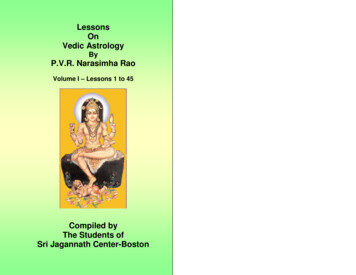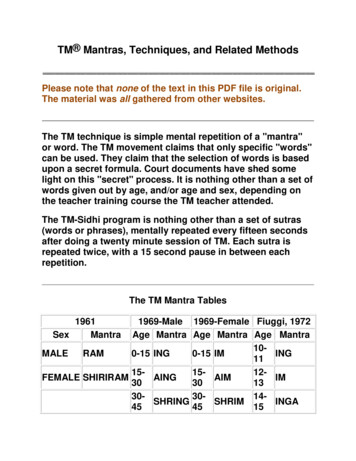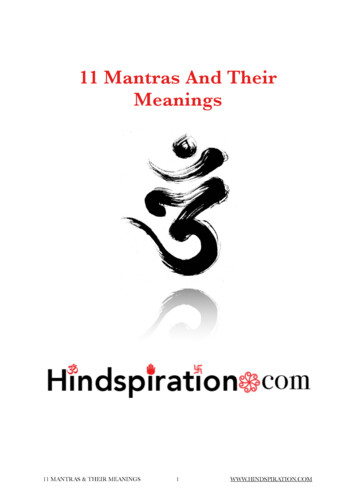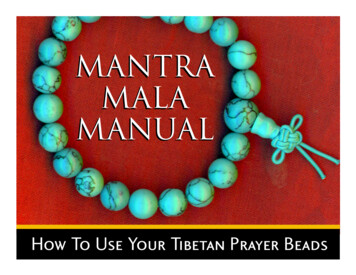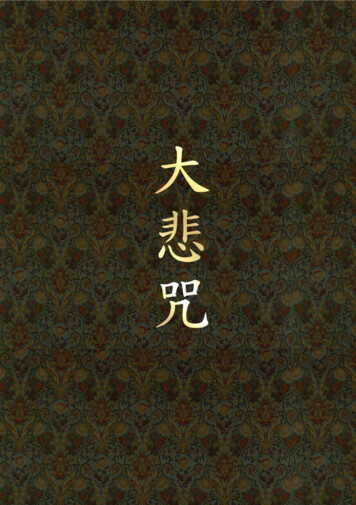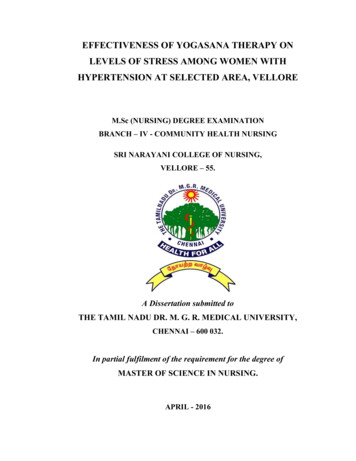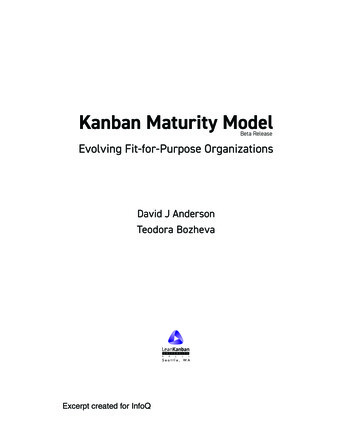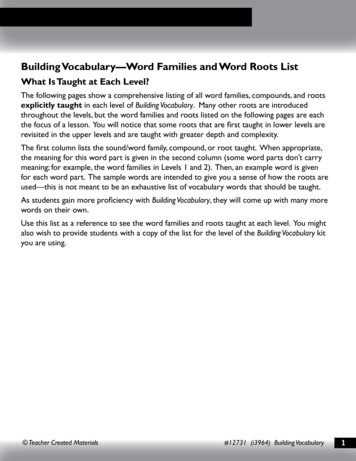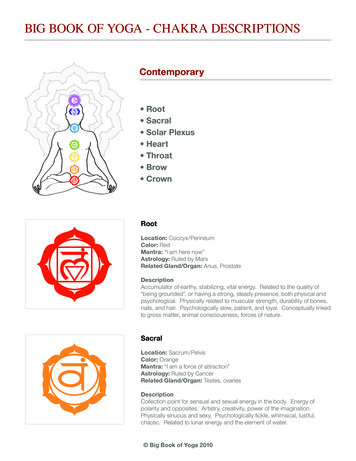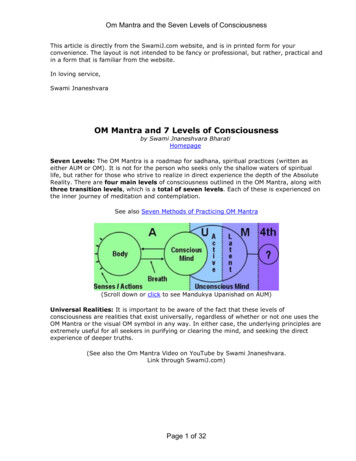
Transcription
Om Mantra and the Seven Levels of ConsciousnessThis article is directly from the SwamiJ.com website, and is in printed form for yourconvenience. The layout is not intended to be fancy or professional, but rather, practical andin a form that is familiar from the website.In loving service,Swami JnaneshvaraOM Mantra and 7 Levels of Consciousnessby Swami Jnaneshvara BharatiHomepageSeven Levels: The OM Mantra is a roadmap for sadhana, spiritual practices (written aseither AUM or OM). It is not for the person who seeks only the shallow waters of spirituallife, but rather for those who strive to realize in direct experience the depth of the AbsoluteReality. There are four main levels of consciousness outlined in the OM Mantra, along withthree transition levels, which is a total of seven levels. Each of these is experienced onthe inner journey of meditation and contemplation.See also Seven Methods of Practicing OM Mantra(Scroll down or click to see Mandukya Upanishad on AUM)Universal Realities: It is important to be aware of the fact that these levels ofconsciousness are realities that exist universally, regardless of whether or not one uses theOM Mantra or the visual OM symbol in any way. In either case, the underlying principles areextremely useful for all seekers in purifying or clearing the mind, and seeking the directexperience of deeper truths.(See also the Om Mantra Video on YouTube by Swami Jnaneshvara.Link through SwamiJ.com)Page 1 of 32
Om Mantra and the Seven Levels of ConsciousnessContents of this article:Seven States of ConsciousnessDirect ExperienceYoga Sutras and OM MantraOM Mantra and other MantrasPracticing the OM Mantra1.2.3.4.5.6.7.Waking / Conscious / Vaishvaanara / Gross / "A" of AUMTransition / UnmaniDreaming / Unconscious / Taijasa / Subtle / "U" of AUMTransition / AladaniDeep Sleep / Subconscious / Prajna / Causal / "M" of AUMSamadhiTuriya / Consciousness / Absolute / Silence after AUMMankukya Upanishad - 12 Verses on AUMSee also these articles:7 Methods with OM MantraMandukya Upanishad on OmHow to use a mantraJapa and Ajapa-Japa with mantraMantra, brain, and wordOM Mantra section of Yoga SutrasYoga, Vedanta, and TantraSix Schools of Indian PhilosophyMaslow's Needs Hierarchy and Yoga PsychologyKundalini AwakeningLevels and Dimensions of ConsciousnessSoham mantra meditationBindu: Pinnacle of Yoga, Vedanta and TantraYoga Nidra CDPage 2 of 32
Om Mantra and the Seven Levels of Consciousness7 States of consciousness in OM MantraSeven states or levels of consciousness are described in this article:Three states of consciousness: Each of the three sounds of AUM Mantra (A, U, and M)symbolizes specific states of consciousness.Fourth state of consciousness: After those three parts of the OM Mantra, there is aSilence, the Fourth, which relates to consciousness or awareness itself.Three transition states: Between these four states of Consciousness there are threetransition states.See also: The four main levels of Consciousness (A, U, M, and Silence of OM Mantra) arealso described in the article Levels and Dimensions of Consciousness.These levels exist universally: It is important to be aware of the fact that these levels ofconsciousness are realities that exist universally, regardless of whether or not one uses theOM Mantra or the visual OM symbol in any way. In either case, the underlying principles areextremely useful for all seekers in purifying or clearing the mind, and seeking the directexperience of deeper truths.Meaning of the symbol: Not only does the sound vibration of theAUM/OM represent the four levels of consciousness, so too does the visualsymbol. The lower curve represents the Gross, Conscious, Waking statelevel, called Vaishvanara. (A of OM Mantra)The center curve represents the Subtle, Unconscious, andDreaming level, called Taijasa. (U of OM Mantra)The upper curve represents the Causal, Subconscious, and DeepSleep level, called Prajna. (M of OM Mantra)The dot, point, or bindu represents the fourth state, the absoluteconsciousness, which encompasses, permeates, and is the otherthree, and is called Turiya. (Silence after A, U, and M of OMMantra)The arc below the dot symbolizes the separateness of this fourthstate, standing above, though ever remaining part of the otherthree. Piercing the bindu finally allows one to attain the highestexperience, and this comes after following the process of KundaliniAwakening.Page 3 of 32
Om Mantra and the Seven Levels of ConsciousnessOther names for the four levels: Different texts and teachings might use different namesfor different characteristics at these four levels; for example, virat, hiranyagarbha, ishvara,and brahman, as well as vaishvanara, taijasa, prajna, and turiya.Swami Rama wrote a profound book on Om Mantra and Mandukya Upanishadentitled "Enlightenment Without God" that has been out of print for manyyears (it is not "anti" God). Here is a link to a download PDF file of this textthat somebody sent me.Direct ExperienceRoadmap for direct experience: The Yogi does not use the information about theselevels as mere intellectual fodder. Rather, the OM Mantra is a roadmap for sadhana,spiritual practices. It is not for the person who seeks only the shallow waters of spiritual life,but rather for those who strive to experience nothing less than the depth of the AbsoluteReality in direct experience.7 methods of practice: See the article:OM Mantra and 7 Methods of PracticeOM Mantra and Transpersonal Psychology: For insight about conceptually bridging thelevels of consciousness outlined in the OM Mantra with the field of TranspersonalPsychology, there is an article relating to the Needs Hierarchy developed by AbrahamMaslow:Maslow's Needs Hierarchy and Yoga PsychologyPage 4 of 32
Om Mantra and the Seven Levels of ConsciousnessYoga Sutras and OM MantraThe Yoga Sutras of Patanjali suggests remembering the meaning of OMMantra as a direct path to Self-realization. Remembering the soundvibration of AUM, along with a deep feeling for the meaning of what itrepresents, brings both the realization of the individual Self and theremoval of obstacles that normally block that realization. (See Sutras1.23-1.29)OM Mantra and other MantrasIt is important to know that OM Mantra is very often used in conjunction with othermantras, usually with the OM being the first or last sound in the whole mantra. Often theseother mantras refer to a specific deity or name of God. Some practitioners consider the OMto literally refer to only one such name of God or deity. Still other practitioners believe theOM refers to some different God or deity. For those born into such religious cultures, thisdiversity of use of OM is well known, and does not cause confusion, while also being awarethat there may be discourses or debates supporting one view or another.However, others who are not familiar with this will benefit by becoming aware that there area variety of ways of using OM Mantra. This leaves it a matter of personal choice how the OMMantra will be used. Regardless of how one uses the mantra, there is a universal truth thatthe vibration of OM will be experienced on the inner journey. In that sense, is not a merebelief or symbolic tool belonging to any one group or groups. Similarly, the existence ofwaking, dreaming, sleep, and that beyond (described below as represented by AUM) arealso universal realities. In the information below, OM Mantra is presented as a means ofcontemplation and meditation, which pierces the three levels of reality and consciousness,revealing the fourth, which permeates the other three.Practicing the OM MantraThe OM Mantra (AUM Mantra; Pranava) is a widely recognized mantra. While the OM Mantrahas a variety of meanings, one of its most significant uses is for Meditation andContemplation in Yoga and Vedanta. The OM Mantra is recommended in the Yoga Sutrasand the Mandukya Upanishad, as well as in many other teachings.Four major levels: When used in this way, the OM Mantra (AUM) has four major levels ofmeaning and experience to the Yogi. Waking: First, is the Waking state, represented by the sound of "A" of the AUMMantra, called Vaishvaanara.Page 5 of 32
Om Mantra and the Seven Levels of Consciousness Dreaming: Second, is the Dreaming state, represented by the sound of "U" of theAUM Mantra, called Taijasa.Deep Sleep: Third, is the Deep Sleep state, represented by the sound of "M" of theAUM Mantra, called Prajna.Turiya: Fourth, is the entire domain of that consciousness that permeates all of theother levels within which awareness does its dance, called Turiya (literally the"fourth"), represented by the Silence after the "A," "U," and "M".Three transition stages: Between these four states of consciousness, there are threetransition stages called Unmani, Aladani, and Samadhi.The Yogi wants to rememberthe 4 parts of the mantra,one after the other,along with the meaning.Remember the four parts one after the other: Thus, in the use of the AUM Mantra,there are four levels of awareness that the Yogi wants to cultivate. The Yogi wants toremember the four parts of the AUM Mantra internally, one after the other, through thelevels of consciousness. (The other three stages are also there, but these four are the mainfocus of the Yogi in using the OM Mantra).Remain aware of the meanings: With practice, it gradually becomes easier for one tomaintain awareness of these meanings as attention moves through the parts of the AUMMantra (The A, U, M, and Silence of OM Mantra). Over time, that awareness bringsincreasing insight of the true nature of these levels of consciousness. Eventually one movesto the direct experience of the Absolute Reality, that consciousness which permeates All(Silence after A, U, and M of OM Mantra). This is the state of Self-realization.Three functions are at the same level: One of the profound insights that one begins toget is the way in which 1) the levels of personal consciousness, 2) the stages of the mentalprocess, and 3) the levels of the universe parallel one another. One comes to see that thesethree are functioning at the same levels of reality, which are none other than the levels ofconsciousness themselves. It is approximately like this: Waking Conscious Gross Vaishvaanara (A of OM Mantra)Dreaming Unconscious Subtle Taijasa (U of OM Mantra)Deep Sleep Subconscious Causal Prajna (M of OM Mantra)Turiya Consciousness Itself, permeating and being All (Silence of OM Mantra)Page 6 of 32
Om Mantra and the Seven Levels of ConsciousnessIn the actual practice with AUM Mantra (OM Mantra): When awareness is on the "A" of the OM Mantra, you cultivate and train yourselfto have a simultaneous awareness of:o the Waking state,o the Conscious level of mental processing, ando the Gross realm of the universeo (Waking, Conscious, and Gross are all at the same level, symbolized by "A" ofthe OM Mantra).When awareness is on the "U" of the OM mantra, you cultivate and train yourselfto have a simultaneous awareness of:o the Dreaming state,o the Active Unconscious processing level of the mind, ando the Subtle realm of the universeo (Dreaming, Unconscious, and Subtle are all at the same level, symbolized byU of the OM Mantra).When awareness is on "M" of the OM Mantra, you cultivate and train yourself tohave a simultaneous awareness of:o the Deep Sleep state,o the Subconscious (latent, dormant, inactive, storage) aspects of mind (theSamskaras from where the impetus for Karma, or action springs forth), ando the Causal realm, out of which arises the Subtle and Gross universeo (Deep Sleep, Subconscious, and Causal are all at the same level, symbolizedby M of the OM Mantra).When awareness is on the Silence after the A, the U, and the M of the OMMantra, you cultivate and train yourself to have an awareness of the consciousness:o that permeates all of the three personal levels (Waking, Dreaming, DeepSleep),o that permeates all of the Subtle realm, ando that also permeates all of the Causal realmo (Consciousness permeates, is the foundation of, and in fact, "is" the whole ofthe levels of the A, the U, and the M levels of the OM Mantra).One of the other elegant and awesome insights is the way in which our own personality,mental and emotional processes operate: Latent impressions begin to stir: We come to see, in direct experience of YogaMeditation and Contemplation, how it is that there are latent impressions in the deepunconscious (the place of Deep Sleep; M of OM Mantra), and how it is thatconsciousness drifts over these latent impressions, causing them to stir from theCausal level (M of OM Mantra).Page 7 of 32
Om Mantra and the Seven Levels of Consciousness These impressions arise into internal action: Then we see the way theseimpressions then arise into action internally in the Unconscious (the ActiveUnconscious associated with unseen mental processes and the Dreaming Sleep level;U of OM Mantra), forming many invisible thought processes, normally onlyexperienced in dreams (this is similar to what psychology calls "primary process").These stirrings come forward into the conscious: Then we see the intriguingway in which those stirrings in the Unconscious (U of OM Mantra) come forward intothe Conscious, Waking state of reality (A of OM Mantra), along with the way in whichthe indriyas, the senses (jnanendriyas of smelling, tasting, seeing, touching, andhearing) and means of expression (karmendriyas of eliminating, procreating,moving, grasping, and speaking) come into play so as to relate to the external world(A of OM Mantra).We can observe the four functions of mind: We come to see how the fourfunctions of mind interact within these levels (A, U, and M of OM Mantra), includingManas (sensory-motor mind), Chitta (storehouse of impressions), Ahamkara (Imaker or ego), and Buddhi (which knows, decides, judges, and discriminates).Seeing all the levels permeated by consciousness: Most importantly, we cometo see the way in which all of these levels are both permeated by, and are themanifestation of consciousness itself:o In Waking state (A of OM Mantra), there is consciousness.o In Dreaming state (U of OM Mantra) there is consciousness.o In Deep Sleep (M of OM Mantra), there is consciousness.o In active thinking (A of OM Mantra), there is consciousness.o In unconscious process (U of OM Mantra), there is consciousness.o In the latent storehouse (M of OM Mantra), there is consciousness.Who we really are, is the consciousness itself: We come to see that who wereally are, is the consciousness itself, not the forms which arise. We declare withconviction, what the sages have said all along, "I am not my thoughts! I am That IAm!"AUM is like the three parts of a river: When recalling these levels of "A," "U," "M," andSilence during practice of the OM Mantra, it is useful to remember the metaphor of a river,which has three parts:1. Bed: The river bed of stones (like the latent, Subconscious or Deep Sleep level andits impressions, symbolized by the "M" of the OM Mantra),2. Flow: The flowing part (like the Active Unconscious, or Dreaming level, symbolizedby the "U" of the OM Mantra), and3. Surface: The surface of the river (like the Conscious, Waking level, symbolized bythe "A" of the OM Mantra).Consciousness at three levels: That reality or presence of existence itself, that is in thethree levels of bed of the river, flow of the river, and surface of the river, is like theconsciousness that permeates the three levels of Waking (A of OM Mantra), Dreaming (U ofOM Mantra), and Deep Sleep (M of OM Mantra). Those three levels are also the Conscious(A of OM Mantra), Active Unconscious (U of OM Mantra), and Latent Unconscious orSubconscious (M of OM Mantra), as well as the Gross (A of OM Mantra), Subtle (U of OMMantra), and Causal (M of OM Mantra) levels of reality. Subconscious: Our Subconscious wants, wishes, desires, attractions, and aversions(samskaras) are like those stones that form the bed of the river (M of OM Mantra).Page 8 of 32
Om Mantra and the Seven Levels of Consciousness Unconscious: When consciousness moves across them, they come to life in the theflow of the Unconscious (U of OM Mantra), like the flow of the river, andConscious: Some burst forth into the Conscious mind (A of OM Mantra), resulting inactions, speech, and conscious thoughts, like the action on the surface of the river.Going beyond the three levels: Through practice, one gradually attains the ability to gobeyond, or deeper than the various levels and thinking processes, to the direct experienceof the source of the consciousness, symbolized by the Silence after the "A," "U," "M," of theOM Mantra.The practice begins simply, is practiced sincerely and faithfully, and expands over time, withever increasing insights about the underlying truths contained in, and suggested by the OMMantra. Meditation on OM (AUM) as an object of concentration, and Contemplation on itsmeaning work together in guiding one towards Self-realization.Tripura: Tri means three, and pura means city. Tripura is theconsciousness that operates in the three cities of Waking (A of OMMantra), Dreaming (U of OM Mantra), and Deep Sleep (M of OMMantra), as well as the Conscious (A of OM Mantra), Unconscious(U of OM Mantra), and Subconscious (M of OM Mantra) aspects ofmind. Sometimes conceptualized as the divine feminine (Shakti),compared to the divine masculine (Shiva), she permeates thethree cities of the Gross world (A of OM Mantra), the Subtle plane(U of OM Mantra), and the Causal reality (M of OM Mantra).Tripura also permeates the many other trinities such as thebeingness inherent in past, present and future.This is a Tantric rendering of the three levels of consciousness mapped out by the OMMantra symbol, and its levels of Vaishvanara (A of OM Mantra), Taijasa (U of OM Mantra),and Prajna (M of OM Mantra). Dedication, devotion, love, and surrender into this creativesource or divine Mother is one of the finest aspects of Tantra as a direct route toRealization. Some conceptualize Tripura as an anthropomorphic deity, while the subtlerpractices are directed towards Tripura as formless, that fourth state beyond the other threecities (A, U, and M of OM Mantra). The Bindu of Sri Yantra is the symbol of this highesttranscendent Reality (Silence of OM Mantra). The quality of the three cities is an aspect ofOM Mantra, Gayatri Mantra, and Mahamrityunjaya Mantra.Page 9 of 32
Om Mantra and the Seven Levels of ConsciousnessSee also the articles:Bindu: The Final ConvergenceKundalini Rising to Crown ChakraExplanations of the 7 levels of consciousness: Below are some explanations of each ofthe seven levels of consciousness mapped out in OM Mantra. As you go through the levelsof the OM Mantra described below, it is best to remember that the key levels for practiceare awareness of the four levels of consciousness related to "A," "U," "M," and the fourthlevel of Silence.[Note: It is very useful to remember that, when describing or reading about subtle levels ofconsciousness, words are inadequate, and can easily seem to be in conflict with oneanother, as one wrestles with varying terminology, or with explanations from one or anotherwriter. Ultimately, it is direct experience through repeated practice, without a break, over along time that will unravel the meaning of the explanations and bring the true insights.]1. Waking / Conscious /Vaishvaanara / Gross / "A" of AUM Mantra"A" represents Waking: The Waking state of consciousness is represented by the "A" ofthe AUM Mantra. The name of this level of consciousness is Vaishvaanara. The Waking state(A of OM Mantra) is experienced by the individual person. In the Waking state ofconsciousness (A of OM Mantra) there are actions, speech, and thoughts of which we are"consciously" aware. The unconscious processes in the deeper levels (U and M of OMMantra) are also there, but just not normally noticed.Microcosm and macrocosm of Waking: If the individual person is the microcosm, thenthe whole of the manifest universe is the macrocosm. The "A" of AUM Mantra represents notonly the individual Waking state of consciousness, but also the entire Gross realm. Theindividual state of Waking consciousness and the Gross realm are all operating at the samelevel of consciousness (both are "in the world").Page 10 of 32
Om Mantra and the Seven Levels of ConsciousnessThe "A" bursts forth: When using AUM as a mantra, notice how the "A" bursts forth in aninstant (whether said aloud, or thought of internally). You could say "Aaaaaaa.," in adrawn out way, but the "A" itself has a very brief, instantaneous bursting forth quality to it.The sound arises quickly, in a flash, from out of the silence. When using the OM Mantra,whether aloud or internally, it is useful to allow yourself to be aware of this bursting forthquality of thoughts, images, or impressions. All of these arise in a moment from the Subtlerplace within (U and M of OM Mantra).Three types of awareness with "A": In the practice of remembering the AUM Mantra,when awareness is on "A" of the OM Mantra, you cultivate and train yourself to have asimultaneous awareness of: the Waking state,the Conscious level of mental and emotional processing, andthe Gross realm of the universe.The awareness of these three operating at the same level of reality is allowed to becomeclearer through practice over time.Observing the "A" come forward: To observe the way the "A" comes forward whenremembering the OM Mantra is to observe the way our whole process of thoughts, actions,and speech arises. This can be extremely useful to understand.2. Unmani / Transitionbetween A and U of OM MantraTransition between Waking and Dreaming: There is a transition stage between Waking(A of OM Mantra) and Dreaming (U of OM Mantra) states (or between Conscious andUnconscious states). The name of this transition stage of consciousness is Unmani. Unmanidoes not just refer to the personal experience between Waking and Dreaming. Rather, it isPage 11 of 32
Om Mantra and the Seven Levels of Consciousnessthe name of that transition level of consciousness itself. (Like many words, the wordUnmani is used in different ways. In other contexts, it is also used to mean Samadhi orTuriya.)We have all experienced this transition: We have all experienced this pleasanttransition at times when about to awaken after a good sleep, and possibly when we are "daydreaming". In this state, you have left the Dreaming world (U of OM Mantra), but have notyet fully come into the Waking (A of OM Mantra), or external world. You might be lyingthere pleasantly, not remembering your name, who you are, where you are, and not reallycaring about these things. But you are also not asleep having any dreams.Increasing awareness of the transitions: When using the OM Mantra for YogaMeditation and Contemplation, the focus is mostly on the three states of Waking (A of OMMantra), Dreaming (U of OM Mantra), and Sleep (M of OM Mantra), which are also called theGross, Subtle, and Causal. However, as it is practiced, there also will be a natural,increasing awareness of the transition phases as well. It will become clearer how it is thatconscious (A of OM Mantra) thoughts, speech, and actions are transitioning from theirunderlying, mostly unconscious (U and M of OM Mantra) thought and emotional processes.Don't confuse this transition with Meditation: This very pleasant state is oftenconfused with Meditation. Meditation is done in the Waking state (A of OM Mantra), in whichone is full awake and alert. Then, gradually the veil is opened to allow the deeper states orlevels (U of OM Mantra) to come forward into the Conscious, Waking state of awareness (Aof OM Mantra).Parallels with science: In relation to the Gross world (A of OM Mantra), it is interesting tonote the parallels between the transition between Unconscious and Conscious thoughtpatterns, and the way the scientists describe the coming forth of the manifest universe as a"big bang". Possibly this too is a form of the coming forth of the Subtle (U of OM Mantra),transitioning into the Gross (A of OM Mantra).Page 12 of 32
Om Mantra and the Seven Levels of Consciousness3. Dreaming / Unconscious /Taijasa / Subtle / "U" of AUM Mantra"U" represents Dreaming: The Dreaming state of consciousness is represented by the "U"of the AUM Mantra. The name of this level of consciousness is Taijasa(U of OM Mantra).Taijasa does not just mean dreaming. Rather, it is the name of that level of consciousnessin which dreaming occurs (U of OM Mantra).Mind working out its desires: The Dreaming state (U of OM Mantra) is a level where themind can work out its unfulfilled wants, wishes, desires, attractions, and aversions notallowed to play out in the external world (A of OM Mantra). Both Yogis and psychologistsspeak of this as a useful process.Uncoloring thought patterns: However, the Yogi will go further in dealing with theunderlying deep impressions (Samskaras) that lead to actions (Karmas). The Yogi wants toturn those colored (klishta) thought patterns uncolored (aklishta) thought patterns so thatthey no longer need to arise and cause disturbance, whether causing that disturbance in theWaking (A of OM Mantra) or Dreaming (U of OM Mantra) states of consciousness (See alsothe article on Klishta and Aklishta Thoughts). It is for this reason that the Yogi gradually andnaturally needs less sleep; there are fewer colored (klishta) unconscious thought patternsPage 13 of 32
Om Mantra and the Seven Levels of Consciousnessneeding to play out. (See Yoga Sutras 1.5, 2.1-2.9, and 2.10-2.11 on coloring anduncoloring)Microcosm and macrocosm of Dreaming: The counterpart of the personal Dream world(U of OM Mantra) is the entire Subtle, psychic, occult, or astral plane of reality (also U of OMMantra). One is the microcosm, while the other is the macrocosm.Lifting the veil: As one progresses in Yoga Meditation, opening to the Unconscious (U ofOM Mantra) begins. One stays in the Waking state (A of OM Mantra), but gradually lifts theveil, opens the curtain, so that the Unconscious (U of OM Mantra) begins to come forward.What comes is that which was normally only accessible in the Dreaming state (U of OMMantra).Intentionally letting the thoughts come: It is in this field of observation that the Yogidoes the Meditation of remaining one-pointed by letting go of the thought patterns arising."Let them come, and let them go," is the message the Yogi says to the mind, as NonAttachment (Vairagya) becomes a reality, not just an act done in the external world. (SeeYoga Sutras 1.12-1.16 on non-attachment)Page 14 of 32
Om Mantra and the Seven Levels of ConsciousnessThe highest therapy: Gradually, the intensity of the coloring attenuates, eventuallyallowing the thought pattern to remain in latent, seed form (until it is dispensed withentirely). It is because of this process of attenuating that the Yogi says that Yoga Meditationis the highest of all therapies. (See Yoga Sutra 2.4 on attenuation)The coloring (klishta) gradually attenuatesTaijasa is not the "spiritual" realm: This level of Taijasa (U of OM Mantra) has oftenbeen confused as being the "spiritual" realm, failing to note that it is only the second of fourlevels of consciousness in AUM Mantra (or third of the seven). If one is not familiar withthis, it can seem that there are only two realms (a Gross and Spiritual) with a Transitionbetween them. One can easily get caught in a trap of pursuing the actions, beings, andobjects of the Subtle realm (U of OM Mantra), not recognizing that they are merely a levelto move through, not a place to go and stay. Journeys in these subtle realms (U of OMMantra) are no more useful in the journey of Self-realization than journeys to a thousandcities in our external world (A of OM Mantra), though some such journeying is sometimesneeded so as to learn the lesson that the journeying is not needed. The article RealizationBeyond the Gross and Subtle describes how it can seem that there are only two levels ofGross and Subtler.Seeking the Subtle is a distraction: Patanjali, codifier of Yoga science describes manysiddhis (powers) that come to the Yogi through practices. Some say that the Yogi is seekingthese powers intentionally. However, Patanjali actually mentions these on the foundation ofNon-Attachment (Vairagya) and Discrimination (Viveka), such that the seeker will abandonthese powers when they come (See Yoga Sutra 3.38). In other words, seeking of thebreadth of the Subtle realm (U of OM Mantra) is a distraction on the journey toenlightenment; with Discriminative Wisdom and Non-Attachment, one is better off to let goof these allurements.Witnessing and going beyond: At the same time that the Yogi observes and lets go ofthe Subtle realm (U of OM Mantra), there is also a beauty in witnessing as one movesforward in the journey. We can surely enjoy the scenery along the way, though it may bebest, the Yogis remind us, to move on to the Realization of the Absolute, which is notsubject to death, decay, or decomposition.Page 15 of 32
Om Mantra and the Seven Levels of ConsciousnessAwareness of the transition: In the practice of remembering the OM Mantra, one allowsthe awareness and feeling associated with the "A" to transition into the awareness andfeeling associated with the "U".Three types of awareness with "U": In the practice of remembering the AUM Mantra,when awareness is on "U" of the OM Mantra, you cultivate and train yourself to have asimultaneous awareness of: the Dreaming state,the Unconscious processing level of the mind, andthe Subtle realm of the universe (Dreaming, Unconscious, and Subtle are all at thesame level).The awareness of these three operating at the same level of reality (U of OM Mantra) isallowed to become clearer through practice over time.Forming the sound of "U": The actual sound is not like the letter "A" and the letter "U,"but is more like "AOOUUUUU." There is "Ah," followed by "UUUUU." (as in
Contemplation in Yoga and Vedanta. The OM Mantra is recommended in the Yoga Sutras and the Mandukya Upanishad, as well as in many other teachings. Four major levels : When used in this way, the OM Mantra (AUM) has
